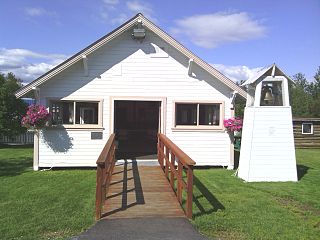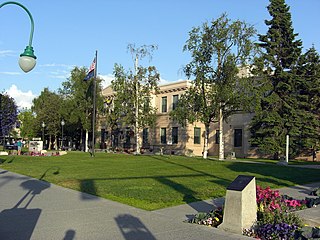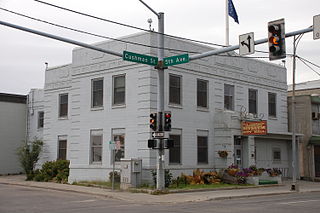
Fort Abercrombie State Historical Park, also known as the Fort Abercrombie State Historic Site, is an Alaska state park on Kodiak Island, Alaska. It includes 182 acres (74 ha) of land at the end of Miller Point, located on the eastern shore of Kodiak Island northeast of the city of Kodiak. The park, established in 1969, is noted for its historical World War II fortifications and its scenery, which includes bluffs overlooking the ocean, spruce forests, and meadows. The site was named in honor of the early Alaska explorer and United States Army officer Lt. Col. William R. Abercrombie. The fortifications, whose surviving elements include gun emplacements, underground magazines, and foundational remnants of buildings, were built in 1941 and abandoned after the war ended, having seen no action.

Wasilla is a city in Matanuska-Susitna Borough, United States and the sixth-largest city in Alaska. It is located on the northern point of Cook Inlet in the Matanuska-Susitna Valley of the southcentral part of the state. The city's population was 7,831 at the 2010 census, up from 5,469 in 2000. Estimates in 2019 put the population at 10,838. Wasilla is the largest city in the borough and a part of the Anchorage metropolitan area, which had an estimated population of 399,148 in 2018.

The Sitka U.S. Post Office and Court House, also known as the Sitka Post Office and now serving as Sitka City Hall, is a Moderne style building located at 100 Lincoln Street in the center of Sitka, Alaska. One of eight Federal buildings constructed in the Alaska Territory in the 1930s, it was listed on the National Register of Historic Places in 1997.

The Alaskan Engineering Commission (AEC) was a U.S. Federal agency, sometimes known by its initials or by alternate spelling Alaska Engineering Commission. It was created by the Alaska Railroad Act in 1914 by U.S. President Woodrow Wilson in order to arrange for the construction of a railway system in Alaska. William C. Edes was named chairman, chief engineer Colonel Frederick Mears. In 1915, the AEC became part of the U.S. Department of the Interior. In 1923, after the railroad began operation and construction was complete, it became the Alaska Railroad Commission, later renamed to The Alaska Railroad.

The Wasilla Depot was built in 1917 in Wasilla, Alaska. It was designed and built by the Alaska Engineering Commission, a federal agency charged with building Alaska's railways. The structure, located at the corner of Parks Highway and Main Street, was restored by the Lions Clubs and the Wasilla Chamber of Commerce.

The Whitney Section House, also known as Whitney Station, is a historic railroad-related building in Wasilla, Alaska. It is a single-story wood frame structure, which was built in 1917 by the Alaska Railroad. It originally stood at mile 119.1, about 4.8 miles (7.7 km) north of Anchorage Station, and was one of a series built by the railroad and located at roughly ten-mile intervals. The area where it stood was taken by the federal government for Elmendorf Air Force Base, and was rescued from demolition by the local chapter of the National Railroad Historical Society. It now stands on the grounds of the Alaska Museum of Transportation and Industry in Wasilla, and has seen a variety of uses.

The Wasilla Elementary School, located near the corner of East Swanson Avenue and North Boundary Street in Wasilla, Alaska is a historic one-room school that was built in 1917. It was Wasilla's first school, and served as its primary school until 1934 when a larger school was built. It is 22 by 36 feet in dimension. It was moved to its present location, in a historic park, shortly before its NRHP nomination in 1979. It had been located about three blocks away. After 1934 it was used again as a school overflow classroom and it also served as a community hall and for weddings, funerals and other events; it served as a Church of Christ for a number of years.

The Gilmore Building, also known as the Gilmore Hotel, is a historic commercial building at 326 Front Street in Ketchikan, Alaska. It is a three-story masonry building located adjacent to Ketchikan City Hall, and was built in 1926-27 by P. J. Gilmore, Sr. to meet growing demand in the growing community for retail space and hotel rooms. The build is in the shape of a reversed L, whose base lies along Front Street, and includes three commercial storefronts. The upper floors are populated with hotel rooms.

The Juneau-Douglas City Museum is located at the corner of 4th and Main, opposite the Alaska State Capitol in Juneau, Alaska. It occupies a building which was built in 1950-51 to house the Juneau Memorial Library. It is a two-story Classical Revival structure built out of concrete with red marble trim elements. A gable-roofed projecting section at the center of the long wall provides the main entrance, which is recessed in an opening the full height to the pediment. This projecting section is flanked by banks of five metal-framed awning windows. The northeast facade has a gable pediment similar to that of the entry projection, below which is a large rectangular window, behind which a stained glass decoration has been installed. The building served the city as its library until the 1980s, at which time it was repurposed to house the city museum.

The Old Anchorage City Hall, also known as Historic City Hall, is located at 524 West Fourth Avenue in Anchorage, Alaska. It is a two-story cast concrete building, designed by E. Ellsworth Sedille and built in 1936 with funding from the Public Works Administration. It housed the city administration of the city until 1979, when most of the integrated city-borough administration was moved to the Hill Building at 632 West 6th Avenue.

The Independence Mines, now Independence Mine State Historic Park, is the site of a former gold mining operation in the Talkeetna Mountains, across Hatcher Pass from Palmer, Alaska. The area's mining history dates to at least 1897, when active claims were reported in the vicinity of Fishook Creek. These early mining efforts were eventually joined to form the Wasilla Mining Company, which worked the mines from 1934 to 1943, and again from 1948 to 1950. The mining operation at Independence was the second-largest hard-rock gold mining operation in the state, after a larger site near Juneau. The company and the miners that preceded it built a substantial mining camp, with as many as sixteen wood frame buildings, which were originally connected to each other by sheltered wooden "tunnels". When the company ended operations in 1950, it had expected to eventually resume operations, but never did; this resulted in a particularly well-preserved collection of mining equipment and buildings, although the weather has since taken a significant toll on the latter.

The Knik Site, also known as the Old Knik Townsite, is the location in Matanuska-Susitna Borough, Alaska that was once home to the largest settlement on Cook Inlet. The only surviving remnants of the community are a former log roadhouse, now a museum operated by the Wasilla-Knik Historical Society, and a log cabin. The Knik area had long been a meeting point of Native Alaskans, and in 1898 it became the principal community on Cook Inlet from which goods were shipped into the interior. In 1916 the Alaska Railroad reached the site of present-day Anchorage, bypassing Knik and leading to Anchorage's growth. When the railroad reached Wasilla, Knik lost all importance as a transshipment point, and its buildings were either abandoned or moved to one of the other communities. Knik is located about 13 miles (21 km) southwest of Wasilla.

The Pioneer Igloo Hall Number 19 is a historic social club building at 621 First Street in Cordova, Alaska. It is a log structure, built in 1927-28 to resemble a typical Alaskan trapper's cabin, and occupies a prominent location overlooking the city's downtown. It was built by the local chapter of the Pioneers of Alaska as a meeting space and community hall. The hall has been the subject of restoration and rehabilitation efforts by the local Pioneers, with statewide listing on an endangered structures list in 2012 and 2013.

The Blanche and Oscar Tryck House is a historic house on North Knik Street in Wasilla, Alaska. Built sometime before 1916 at Knik, it was the first house in Wasilla when the community was established, moved there by the Trycks in 1917. It is a single-story wood frame structure, roughly rectangular in shape, with a concrete foundation and a corrugated metal gable roof configured to capture rainwater for laundry and other uses. It has a brick chimney and a root cellar, and has been vacant since Oscar Tryck died in 1964.

Teeland's Country Store, also known as Herning's and Knik Trading Company, is a historic retail establishment located at the corner of East Herning Avenue and North Boundary Street in Wasilla, Alaska. The oldest portion of this wood frame building is a log structure at the back whose construction dates to 1905. Originally located at Knik, this log structure, then also used as a store, was moved to the newly established town of Wasilla in 1917 by its builder, O. G. Herning. Herning also built the present utilitarian wood frame structure, which still operates today. The business was purchased by Walter Teeland in 1947, giving it its present name.

The Old City Hall, now the Fairbanks Distilling Company, is a historic civic building at 410 Cushman Street in Fairbanks, Alaska. It is a two-story Art Deco structure, built out of reinforced concrete in 1935 as a fireproof alternative to the city's previous city hall. The building is roughly T-shaped, with quoining patterns incised in the corners and bands of decoration on a parapet level. The building was originally built to house city offices as well as police and fire stations; the entrances to the fire equipment bays on Cushman Street have been filled in with wood framing and siding. The building was enlarged by extensions to the rear twice, once before 1950, and once after the 1967 floods. The city moved its offices to the adjacent Main School in 1994; the building then housed the Fairbanks Community Museum until it was acquired by Fairbanks Distilling Company in July 2014.

The Sutton Community Hall is a historic municipal building in Sutton, Alaska. It is located on the west side of Jonesville Road, about 0.25 miles (0.40 km) north of its junction with the Glenn Highway. It is a single-story wood frame structure, measuring 40 by 70 feet, with a shallow-pitch gabled sheet metal roof. The building has entrances on the north, south and east sides, the east-facing one sheltered by a hood with diagonal bracing. The exterior has several types of cladding, including asphalt shingles and board-and-batten siding. The building was built in 1927 to serve as a bunkhouse for workers building the Eklutna Power Plant, and was moved to the present location in 1950 to serve the unincorporated community of Sutton as a meeting space. The hall served the community as its principal civic and social meeting space for forty years.

Old St. Joseph's Catholic Church, now Old St. Joe's Hall, is a historic former church building at Anvil City Square in Nome, Alaska.

Cunningham-Hall PT-6 NC692W is one of two surviving aircraft of its type from the early days of aviation in the history of Alaska. The Cunningham-Hall PT-6 is a single-engine six-seat cabin biplane built by the Cunningham-Hall Aircraft Corporation, which was designed mainly as a personal transport. The aircraft, registered as NC692W, with c/n. 2962, was built in 1930 and is the second of its kind constructed. It was entirely rebuilt as a static display using non-airworthy materials in the 1970s.

The Big Creek Schoolhouse, also known as Polk City Schoolhouse and Polk City City Hall, is a historic building located in Polk City, Iowa, United States. It was built in 1863 when the community was known as Big Creek. It is the work of master builder John Adam Schall, who was able to adapt heavy timber framing for the construction of the two-story Greek Revival structure. It served as a schoolhouse and community center from the time it was built until 1893. It became Polk City's city hall the following year, and continued to serve as a community center. A full-size addition was completed on the back of the building in 1915. Two one-story additions were constructed later in the 20th century. A frame addition was built in 1964 on the southwest corner of the main block, and a frame lean-to was added onto the north elevation in 1984. In 1966 the outside staircase, which was the only way to access the second floor, was removed.


















